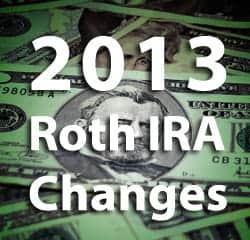Once again it’s mid-October – the time of year when the IRS announces modifications to the Roth IRA contribution and income limits.
It’s important to pay attention to any upcoming changes in IRS rules, because modifications to contribution limits, annual income limits, or other factors can change the trajectory of your retirement plans. So let’s take a quick look at what’s changed.
Quick Navigation
The 2013 Roth IRA Contribution Limit
For the year 2013, the IRS raised the maximum Roth IRA contribution limit. This is the first increase in the limit since 2008 when it increased $1,000.

- $5,500 if you’re under age 50
- $6,500 if you’re age 50 or older
Keep in mind that you qualify for the $6,500 maximum contribution as long as you turn 50 years old on any calendar day in the calendar year. So, for instance, let’s say you turn 50 years old on December 31, 2013. You can contribute $6,500 to your Roth IRA for the 2013 tax year on May 1st, even though you’ll technically only be 49 years old when you make the actual contribution.
However, you may not be eligible to make the maximum contribution. Due to your income, you might have a smaller contribution limit or earn too much to make any contribution at all. That’s because the IRS sets income limits that determine whether or not you’re eligible to make a Roth IRA contribution. And in the upcoming year, those income limits will change too.
2013 Roth IRA Income Limits
As is the case in most years, the IRS has increased the Roth IRA income limits in an effort to keep pace with inflation. Below are the new limits determined by your tax filing status:
Married Filing Jointly
If you plan to file your taxes as “married filing jointly,” then you can contribute a maximum of:
- $5,500 if your income is $178,000 or less and you’re younger than age 50
- $6,500 if your income is $178,000 or less and you’re age 50 or older
- $0 if your income is $188,000 or more, regardless of your age
If you earn somewhere between $178,001 and $188,000, then your maximum contribution limit phases out to zero based on the IRS phase out rules.
Single, Head of Household, or Married Filing Separately
If you plan to file your taxes as “single, head of household, or married filing separately (assuming you didn’t live with your spouse at any time during the year),” then you can contribute a maximum of:
- $5,500 if your income is $112,000 or less and you’re younger than age 50
- $6,500 if your income is $112,000 or less and you’re age 50 or older
- $0 if your income is $127,000 or more, regardless of your age
If you earn somewhere between $112,001 and $127,000, then your maximum contribution limit phases out to zero based on the IRS phase out rules.
Married Filing Separately
If you plan to file your taxes as “married filing separately,” but you did live with your spouse at some point during the year, then you can contribute a maximum of:
- $5,500 if your income is $0 and you’re younger than age 50
- $6,500 if your income is $0 and you’re age 50 or older
- $0 if your income is $10,000 or more, regardless of your age
If you earn somewhere between $1 and $10,000, then your maximum contribution limit phases out to zero based on the IRS phase out rules.
Roth IRA Conversions
What about Roth IRA conversions?
The Roth IRA conversion rules in 2013 are the same as the 2012 rules, meaning anyone can convert a 401k or a Traditional IRA to a Roth IRA regardless of income.
In years past, the IRS barred high income earners from making Roth IRA conversions. But in 2010, Congress allowed the $100,000 income limit on Roth IRA conversions to disappear. It may reappear sometime in the future, but as of now, it looks like 2013 will be another year without the conversion income limit. So if you’re a high income earner who’s never taken the opportunity to make a Roth IRA contribution, take advantage!
Anyone, regardless of income, can make non-deductible Traditional IRA contributions, then convert those non-deductible Traditional IRA contributions to a Roth IRA tax free (since your original contributions have already been taxed). Effectively, it’s a back door method for high income earners to make Roth IRA contributions.
However, if you choose to go this route, beware of the pitfalls. Seek the advice of a financial professional who can guide you through the process – especially if you’ve made Traditional IRA contributions in the past. The IRS doesn’t allow you to segregate your non-deductible and deductible Traditional IRA contributions when making a conversion, so if you currently have a Traditional IRA, odds are that you’ll owe taxes on a conversion.
Summary
Similar to 2012, the 2013 Roth IRA rule changes were relatively minor.
The maximum annual contribution limits slightly increased to $5,500 and $6,500 respectively.
And the annual income limits also increased with the range for married couples moving from $173,000-$183,000 to $178,000-$188,000 while the range for singles changed from $110,000-$125,000 to $112,000-$127,000.
As of this writing, all other rules and limits remain the same year over year.
Check out the 2013 401(k) Changes. Click here.
This article was written by Britt at http://www.your-roth-ira.com, the Web’s #1 resource for Roth IRA information. You can follow him on Twitter.

I wasn’t aware of the contribution increase for next year yet. Thanks for bringing that to my attention. I love Roth IRAs and will try to max out next year for sure.
Thanks for the info. It’s ironic that there are limits as to how much you can put into a Roth IRA per year. The government doesn’t want to incentivize saving TOO much because then it would slow down spending which would slow down the economy…it’s unfortunate that savers are losers with some policies.